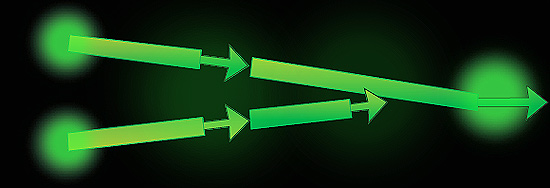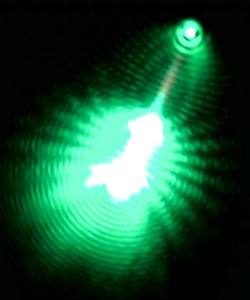The construction of a logic gate in which the logic state can be changed
by a pulse of light instead of applying a voltage can mean the
beginning of the end of current electronics and high chance of the Nobel
Prize for scientists who developed the new technology.
The essence of the development is a logic switch created through the use of cadmium sulphide nanostructures on silicon substrate.
To make the switch, the scientists used a pair of nanowires; two such switches formed a NAND gate. During the test, pulses of laser light changed the output state in accord with the logic of the gate.
The most difficult and spectacular achievement was the 1,1 -> 0 state, when two "1" input signals resulted in "0" output - one light pulse blanked the other!
The essence of the development is a logic switch created through the use of cadmium sulphide nanostructures on silicon substrate.
To make the switch, the scientists used a pair of nanowires; two such switches formed a NAND gate. During the test, pulses of laser light changed the output state in accord with the logic of the gate.
The most difficult and spectacular achievement was the 1,1 -> 0 state, when two "1" input signals resulted in "0" output - one light pulse blanked the other!
The basic switch is made of two nanowires, two such switches form a NAND gate
Possible combinations of logic states
NAND
gates enable realization of all logic functions. The development of
"optical" NAND gate may open the way for the construction of advanced
integrated circuits, operating with optical signals, instead of electric
charges.
The
new technology may revolutionize ICT industry. Optical integrated
circuits used in photonic computers should use less energy, be almost
completely resistant to electromagnetic interference, and - perhaps most
important - be much faster.
The introduction of photonic computers will also accelerate the development of optical fiber technology, currently hampered by comparatively expensive and inefficient media converters (from electrical to optical and optical to electrical form).
One of the scientists, professor Ritesh Agarwal, University of Pennsylvania, said that the research brings us closer to "a future where consumer electronics become consumer photonics."
The introduction of photonic computers will also accelerate the development of optical fiber technology, currently hampered by comparatively expensive and inefficient media converters (from electrical to optical and optical to electrical form).
One of the scientists, professor Ritesh Agarwal, University of Pennsylvania, said that the research brings us closer to "a future where consumer electronics become consumer photonics."
On-chip laser light source made of CdS nanowire
source: www.upenn.edu
Photonics
is a field of science that combines electronics, ICT and optics to
develop techniques and devices that use light for information
processing. Photonics can be understood as analogous to electronic
science, with photons as the basic information carriers, instead of
electrons. The origins of this field of science are associated with the
invention of laser in 1960, development of the first semiconductor light
emitters in the early 1960s, and emergence of fiber optic technology in
the mid-1970s.


No comments:
Post a Comment